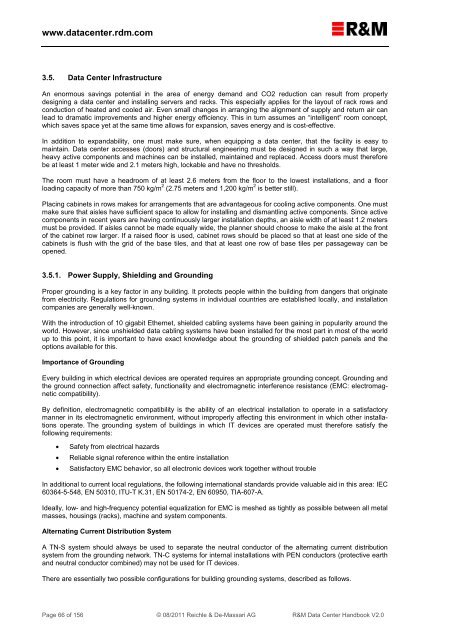R&M Data Center Handbook
R&M Data Center Handbook
R&M Data Center Handbook
Create successful ePaper yourself
Turn your PDF publications into a flip-book with our unique Google optimized e-Paper software.
www.datacenter.rdm.com<br />
3.5. <strong>Data</strong> <strong>Center</strong> Infrastructure<br />
An enormous savings potential in the area of energy demand and CO2 reduction can result from properly<br />
designing a data center and installing servers and racks. This especially applies for the layout of rack rows and<br />
conduction of heated and cooled air. Even small changes in arranging the alignment of supply and return air can<br />
lead to dramatic improvements and higher energy efficiency. This in turn assumes an “intelligent” room concept,<br />
which saves space yet at the same time allows for expansion, saves energy and is cost-effective.<br />
In addition to expandability, one must make sure, when equipping a data center, that the facility is easy to<br />
maintain. <strong>Data</strong> center accesses (doors) and structural engineering must be designed in such a way that large,<br />
heavy active components and machines can be installed, maintained and replaced. Access doors must therefore<br />
be at least 1 meter wide and 2.1 meters high, lockable and have no thresholds.<br />
The room must have a headroom of at least 2.6 meters from the floor to the lowest installations, and a floor<br />
loading capacity of more than 750 kg/m 2 (2.75 meters and 1,200 kg/m 2 is better still).<br />
Placing cabinets in rows makes for arrangements that are advantageous for cooling active components. One must<br />
make sure that aisles have sufficient space to allow for installing and dismantling active components. Since active<br />
components in recent years are having continuously larger installation depths, an aisle width of at least 1.2 meters<br />
must be provided. If aisles cannot be made equally wide, the planner should choose to make the aisle at the front<br />
of the cabinet row larger. If a raised floor is used, cabinet rows should be placed so that at least one side of the<br />
cabinets is flush with the grid of the base tiles, and that at least one row of base tiles per passageway can be<br />
opened.<br />
3.5.1. Power Supply, Shielding and Grounding<br />
Proper grounding is a key factor in any building. It protects people within the building from dangers that originate<br />
from electricity. Regulations for grounding systems in individual countries are established locally, and installation<br />
companies are generally well-known.<br />
With the introduction of 10 gigabit Ethernet, shielded cabling systems have been gaining in popularity around the<br />
world. However, since unshielded data cabling systems have been installed for the most part in most of the world<br />
up to this point, it is important to have exact knowledge about the grounding of shielded patch panels and the<br />
options available for this.<br />
Importance of Grounding<br />
Every building in which electrical devices are operated requires an appropriate grounding concept. Grounding and<br />
the ground connection affect safety, functionality and electromagnetic interference resistance (EMC: electromagnetic<br />
compatibility).<br />
By definition, electromagnetic compatibility is the ability of an electrical installation to operate in a satisfactory<br />
manner in its electromagnetic environment, without improperly affecting this environment in which other installations<br />
operate. The grounding system of buildings in which IT devices are operated must therefore satisfy the<br />
following requirements:<br />
• Safety from electrical hazards<br />
• Reliable signal reference within the entire installation<br />
• Satisfactory EMC behavior, so all electronic devices work together without trouble<br />
In additional to current local regulations, the following international standards provide valuable aid in this area: IEC<br />
60364-5-548, EN 50310, ITU-T K.31, EN 50174-2, EN 60950, TIA-607-A.<br />
Ideally, low- and high-frequency potential equalization for EMC is meshed as tightly as possible between all metal<br />
masses, housings (racks), machine and system components.<br />
Alternating Current Distribution System<br />
A TN-S system should always be used to separate the neutral conductor of the alternating current distribution<br />
system from the grounding network. TN-C systems for internal installations with PEN conductors (protective earth<br />
and neutral conductor combined) may not be used for IT devices.<br />
There are essentially two possible configurations for building grounding systems, described as follows.<br />
Page 66 of 156 © 08/2011 Reichle & De-Massari AG R&M <strong>Data</strong> <strong>Center</strong> <strong>Handbook</strong> V2.0


